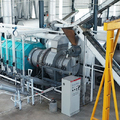With increasing demand for sustainable solutions in waste management, pyrolysis technology has emerged as an effective means of converting waste into usable fuel. A pyrolysis plant processes various materials, including plastic and tyres, converting them into pyrolysis oil. While both plastic and tyre pyrolysis oils share similarities, they differ significantly in composition, properties, and potential applications. These distinctions are essential for industries considering pyrolysis oil as an alternative energy source or chemical feedstock.
Environmental Considerations
The environmental impact of pyrolysis oil depends on its sulfur content, potential contaminants, and carbon footprint during production and combustion. Plastic pyrolysis oil, with its lower sulfur and cleaner composition, often results in fewer emissions when used as a fuel. Its production from non-recyclable plastics also contributes to waste reduction, as it diverts plastic from landfills and incineration.
Tyre pyrolysis oil, while effective in specific applications, requires careful management due to its sulfur and aromatic compound content. Additional desulfurization steps may be necessary to reduce emissions, adding to production costs and processing time. However, the use of tyre pyrolysis oil can also contribute to environmental benefits by repurposing scrap tyres, which pose a significant disposal problem in landfills. A well-designed tyre pyrolysis plant with emission control measures can effectively mitigate these concerns, making tyre pyrolysis oil a sustainable fuel option in suitable industries.

Economic Implications
The economic viability of using pyrolysis oils depends on factors like feedstock availability, processing costs, and end-market demand. Plastic pyrolysis oil often has higher market demand due to its lower sulfur content and cleaner properties, making it an attractive alternative to diesel and furnace oil. This demand can drive investment in plastic pyrolysis plant focused on plastic waste, especially as industries increasingly seek lower-emission fuel sources.
Tyre pyrolysis oil, though more complex, holds value in markets with high fuel demands and less stringent sulfur regulations. Its lower production cost and availability make it a cost-effective choice for industrial sectors that require heavy fuel oil, providing a viable revenue stream for plants processing large quantities of scrap tyres. Both types of pyrolysis oil represent economic opportunities in waste management, although specific market needs and regulatory environments will influence which oil type is more profitable in a given region.
Composition and Chemical Properties
The composition of pyrolysis oil depends on the feedstock material, as different polymers and additives influence the chemical makeup of the resulting oil. Plastic pyrolysis oil, derived from waste plastics, primarily contains long-chain hydrocarbons. Polyethylene (PE), polypropylene (PP), and polystyrene (PS) are among the most common plastics used in pyrolysis processes. These materials produce oil rich in paraffins and olefins, resulting in a lighter oil with a lower sulfur content compared to tyre pyrolysis oil.
Tyre pyrolysis oil, on the other hand, has a more complex composition due to the rubber, fillers, and various chemical additives used in tyres. Tyres are typically composed of natural and synthetic rubber, carbon black, sulfur, and steel reinforcements. As a result, tyre pyrolysis oil contains a higher concentration of aromatic compounds and sulfur, making it denser and more chemically complex than plastic-derived oil. This high sulfur content requires additional treatment steps for certain applications, as sulfur can contribute to environmental pollution when the oil is burned.
Physical Characteristics
The physical properties of plastic pyrolysis oil and tyre pyrolysis oil differ, influencing their suitability for specific applications. Plastic pyrolysis oil generally has a lower viscosity, a lighter color, and a higher heating value compared to tyre pyrolysis oil. This lower viscosity makes it easier to handle and pump, especially in cold environments, which can be advantageous for storage and transportation. The high heating value of plastic pyrolysis oil also makes it an efficient source of energy for power generation.
Tyre pyrolysis oil, in contrast, is more viscous, darker in color, and heavier due to the presence of aromatic hydrocarbons and carbon residues. This oil has a slightly lower heating value than plastic pyrolysis oil but is still viable as a fuel alternative. Its high carbon content can be beneficial for applications that require denser fuel, though the viscosity may necessitate pre-treatment or blending for efficient handling and combustion.

Energy Applications and Industrial Uses
Both plastic and tyre pyrolysis oils can be used as fuel in various energy applications; however, the differences in chemical composition and physical properties affect their optimal use cases. Plastic pyrolysis oil is often favored for electricity generation and industrial heating, as its low sulfur content reduces the risk of sulfur emissions. Its cleaner-burning nature makes it suitable for industries with strict emission regulations, and it can often be blended with traditional diesel or furnace oils for broader applications.
Tyre pyrolysis oil, on the other hand, has a more specific set of applications. Its higher density and sulfur content make it an effective fuel source for industries that operate heavy machinery or require heat-intensive processes. Tyre pyrolysis oil is commonly used in cement kilns, boilers, and industrial furnaces, where high temperatures are needed, and emission standards allow for higher sulfur content. Additionally, the aromatic compounds present in tyre pyrolysis oil make it a potential feedstock for chemical industries that produce benzene, toluene, and xylene, although this requires extensive refining.
Conclusion
Plastic and tyre pyrolysis oils serve as practical outputs from pyrolysis plants, each with unique properties suited to different applications. While plastic pyrolysis oil is cleaner and lighter, making it versatile for a range of energy uses, tyre pyrolysis oil’s density and composition align it with specific heavy-industry demands. As pyrolysis technology advances, the capability to tailor oil properties for target applications will enhance the value of both plastic and tyre pyrolysis oils, supporting sustainable waste-to-energy solutions and contributing to resource efficiency.





